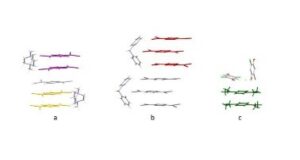Petra Stanić1, Krešimir Molčanov1
1Ruđer Bošković Institute, Zagreb, Croatia

Crystals of planar organic radicals are an interesting tool in crystal engineering for studying π–interactions and π–stacking.1 Organic radicals usually form strong stacking interactions with short distance between ring planes and with energy higher than -15 kcal mol-1. Quantum mechanical models indicate that these interactions can have non-negligible covalent character (two-electron multicentric bonding – pancake bonding).2 Pronounced π-stacking motifs contribute to properties of the material, like electric conductivity and magnetism.3 Today we use different crystallographic methods to study this phenomenon in detail. Here we present a study on strong π–interaction, pancake bonding, in three different salts: 7,7,8,8-tetracyanoquinodimethane (TCNQ) salts with 1,4-dimethyl-DABCO (1) and N,N-dipyridylmethanium (2) and N,N,N′,N′-tetramethyl-p-phenylenediamine (TMPD) chloride salt cocrystal with 2,5-dichlorohydroquinone (3). In crystal structures of studied compounds, there are two different types of stacks observed; dimers and trimers of TCNQ anions and dimers of TMPD cations. Prepared crystals were studied by a combination of variable-temperature crystallography (80 − 400 K) and X-ray charge density.[4] These methods tested stability of prepared compounds and revealed fine details of electron density between the stacked molecules. In all three structures expected temperature dependent changes were noticed; distances between ring planes increased with increasing the temperature. Crystals 1 and 2 were stable from 80–400 K while crystal 3 was stable up to arround 340 K. Within this work pancake-bonding between radical cations was studied for the first time by X-ray charge density.
References:
[1] K. Molčanov and B. Kojić-Prodić, IUCrJ 6 (2019) 156–166.
[2] V. Milašonović, A. Krawczuk, K. Molčanov and B. Kojić-Prodić, Cryst. Growth Des. 20 (2020) 5435–5443.
[3] I. Ratera and J. Veciana, Chem. Soc. Rev. 41 (2012) 303–349 [4] V. Milašinović, K. Molčanov, A. Krawczuk, N.E. Bogdanov, B. A. Zakharov, E. V. Boldyreva, C. Jelsch and B. Kojić-Prodić, IUCrJ 8 (2021) 644–654.
Keywords: π-stacking; pancake bonding; organic radicals
